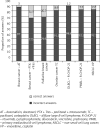Clinical practice in secondary prophylaxis and management of febrile neutropenia in Poland: results of the febrile neutropenia awareness project
- PMID: 25784842
- PMCID: PMC4355660
- DOI: 10.5114/wo.2014.47905
Clinical practice in secondary prophylaxis and management of febrile neutropenia in Poland: results of the febrile neutropenia awareness project
Abstract
Aim of the study: This paper presents the second part of the GoPractice project involving oncologists from seven Polish provinces. The aim of this part of the project was to assess the knowledge of oncologists on indications for granulocyte colony-stimulating factor (G-CSF) secondary prophylaxis (SP) of febrile neutropenia (FN) and FN management based on current therapeutic guidelines (Polish Society of Clinical Oncology [PTOK] and European Organisation for Research and Treatment of Cancer [EORTC]).
Material and methods: The project involved 169 oncologists from 7 regions working in large specialist oncological centers, university hospitals, regional and city hospitals, specialist outpatient clinics and oncological wards in small, local hospitals. The participants completed a questionnaire based on 7 prepared clinical cases of patients with different tumor types and patient characteristics, receiving chemotherapy (CT) with different levels of FN risk. Participants answered questions related to FN risk assessment and G-CSF use as secondary prophylaxis (SP) and for the management of FN. After completing the questionnaire, the participants proceeded to an educational module in which they were provided with an analysis of correct diagnostic and therapeutic procedures according to the PTOK and EORTC guidelines.
Results and conclusions: Indications for G-CSF SP were generally well recognized: in nearly 90% of responses, oncologists assessed correctly indications/lack of indications for secondary prophylaxis, in accordance with guideline recommendations and Experts' opinion. However, the use of daily G-CSFs was often recommended by the study participants for the management of FN. This clinical practice is contradictory to PTOK and EORTC recommendations and may unnecessarily increase treatment costs. Changing this clinical approach may be achieved through regular training to improve guideline adherence.
Keywords: G-CSF; chemotherapy induced neutropenia; febrile neutropenia prophylaxis.
Figures



Similar articles
-
Clinical practice in febrile neutropenia risk assessment and granulocyte colony-stimulating factor primary prophylaxis of febrile neutropenia in Poland.Contemp Oncol (Pozn). 2014;18(6):419-24. doi: 10.5114/wo.2014.47904. Epub 2014 Dec 31. Contemp Oncol (Pozn). 2014. PMID: 25784841 Free PMC article.
-
2010 update of EORTC guidelines for the use of granulocyte-colony stimulating factor to reduce the incidence of chemotherapy-induced febrile neutropenia in adult patients with lymphoproliferative disorders and solid tumours.Eur J Cancer. 2011 Jan;47(1):8-32. doi: 10.1016/j.ejca.2010.10.013. Epub 2010 Nov 20. Eur J Cancer. 2011. PMID: 21095116
-
Biosimilar filgrastim treatment patterns and prevention of febrile neutropenia: a prospective multicentre study in France in patients with solid tumours (the ZOHé study).BMC Cancer. 2018 Nov 16;18(1):1127. doi: 10.1186/s12885-018-4986-1. BMC Cancer. 2018. PMID: 30445935 Free PMC article.
-
Colony-stimulating factors for the management of neutropenia in cancer patients.Drugs. 2002;62 Suppl 1:1-15. doi: 10.2165/00003495-200262001-00001. Drugs. 2002. PMID: 12479591 Review.
-
Is febrile neutropenia prophylaxis with granulocyte-colony stimulating factors economically justified for adjuvant TC chemotherapy in breast cancer?Support Care Cancer. 2016 Jan;24(1):387-394. doi: 10.1007/s00520-015-2805-7. Epub 2015 Jun 17. Support Care Cancer. 2016. PMID: 26081595
References
-
- Lyman GH. Guidelines of the National Comprehensive Cancer Network on the use of myeloid growth factors with cancer chemotherapy: a review of the evidence. J Natl Compr Canc Netw. 2005;3:557–71. - PubMed
-
- Lyman GH. Impact of chemotherapy dose intensity on cancer patient outcomes. J Natl Compr Canc Netw. 2009;7:99–108. - PubMed
-
- Chirivella I, Bermejo B, Insa A, et al. Optimal delivery of anthracycline-based chemotherapy in the adjuvant setting improves outcome of breast cancer patients. Breast Cancer Res Treat. 2009;114:479–84. - PubMed
-
- Bosly A, Bron D, Van Hoof A, et al. Achievement of optimal average relative dose intensity and correlation with survival in diffuse large B-cell lymphoma patients treated with CHOP. Ann Hematol. 2008;87:277–83. - PubMed
LinkOut - more resources
Full Text Sources
Other Literature Sources
Research Materials
Miscellaneous
